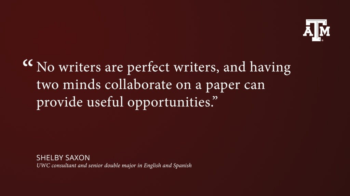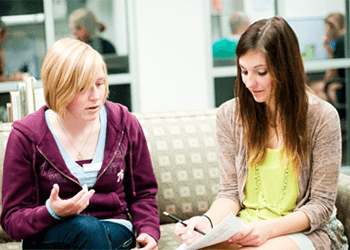University Writing Center Marks 15 Years Of Growth And Innovation
Now in its 15th year of operation, the Texas A&M University Writing Center is one of the largest in the country.
 Now in its 15th year of operation, the Texas A&M University Writing Center is one of the largest in the country and a national model for imparting writing-related knowledge and techniques to Texas A&M faculty and students at all levels, and in all disciplines.
Now in its 15th year of operation, the Texas A&M University Writing Center is one of the largest in the country and a national model for imparting writing-related knowledge and techniques to Texas A&M faculty and students at all levels, and in all disciplines.
“We emphasize that we’re here for long haul, not just to help students with the paper that’s due next week, but to help them truly become writers who think and communicate clearly,” says Dr. Valerie Balester, UWC executive director, who has been with the center since it opened in 2001. “By doing this, we help produce graduates who are well-rounded and ready for leadership roles.”

The UWC has 10 staff members and handled more than 12,500 consultations in 2015-16 (about 400 more than the previous year), facilitated by about 60 student-consultants at locations in Sterling C. Evans Library and West Campus Library.
What accounts for the UWC’s success, and sets it apart from programs at other universities? UWC Director Dr. Candace Hastings say it’s because the UWC provides the following:
- Help with all forms of scholarly communication, including public speaking, presentations and posters.
- It’s open six days a week, and offers consultations via email and web conferencing, as well as face-to-face.
- With about 60 student consultants, it’s one of the biggest in the country.
- 25-minute consultations were added this fall. 45-minute meetings also are available.
- It’s not just for struggling writers. Even the best writing benefits from an objective review.
- An emphasis on graduate students as well as undergraduates; at most universities, services for graduate students are much smaller and offered separately.
- A focus on integrating writing across disciplines through writing-intensive courses required for all students, as well as significant outreach to faculty, including resources on how to design, teach and assess student work in writing-heavy courses.
- Innovative technology. This includes a scheduling and document uploading system, designed in-house, that is seamless for clients and provides consultants with information about the client’s previous interactions. Other examples are several locally produced podcasts and tutorials, and hundreds of other student and faculty resources available on the UWC website.
“Like Texas A&M, we have grown and changed,” Hastings says. “Visual communication is much more important now, so we’re adding programs on how it intersects with written and oral communication. And students want more support and accountability, so we’re adding weekly ‘Write Watchers’ writing sessions for graduate students to complement similar programs held twice per semester for undergraduates.
“Most of all, we want to dispel the notion that writing is magic. It’s not. There’s a process for good writing, and it involves much more than simply avoiding spelling or grammar mistakes. And once it’s mastered, the sky’s the limit.”
